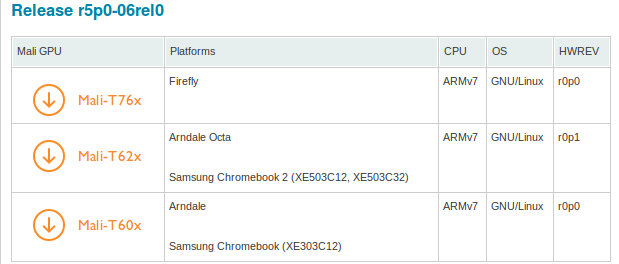ARM Mali GPU drivers includes both open source kernel drivers, and binary userspace drivers supporting framebuffer and/ior X11 implementation. The former is rarely an issue and is quickly released, but the latter requires porting and testing for a specific hardware platform, as well legal work, which greatly delay the releases.

Mali-T880 GPU was announced at the beginning of the month together with ARM Cortex A72, and on February 17, 2015, ARM released an update to their Mali-T600 series, Mali-T700 series & Mali-T860/T880 GPU kernel device drivers with revision r5p1-00rel0 that adds supports to Mali-T860 and Mali-T880 GPU. These open source drivers are available for Android and Linux, and also support early Mali-T700 and T600 GPUs.
Separately, the company has also released Mali-T76X GPU drivers for Firefly board powered by Rockchip RK3288 quad core Cortex A17 processor featuring a Mali-T764 GPU. The first release only supports the framebuffer driver, but ARM is expecting to be able to release the X11 version in the next release (r5p1) planned at the end of March, which means some Linux desktop graphics accelerated will soon be available on Rockchip RK3288, and not only some OpenGL ES 3.0 demos on the framebuffer. The latest release (r5p0-06rel0) also supports Exynos powered Arndale Octa board, Samsung Chromebook 2, Arndale board, and Samsung Chromebook. According to an ARM representative, Rockchip also plans to release their own Linux GPU drivers targeting “TopMetal” hardware platform (should probably read PopMetal).

Jean-Luc started CNX Software in 2010 as a part-time endeavor, before quitting his job as a software engineering manager, and starting to write daily news, and reviews full time later in 2011.
Support CNX Software! Donate via cryptocurrencies, become a Patron on Patreon, or purchase goods on Amazon or Aliexpress




